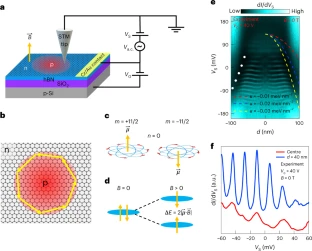Nanowerk March 6, 2023
Single quantum dots and coupled quantum dots formed with massless Dirac fermions can be viewed as artificial relativistic atoms and molecules, respectively. Such structures offer a unique testbed to study atomic and molecular physics in the ultrarelativistic regime. An international team of researchers (USA – UC Santa Cruz, UK, Japan) used a scanning tunnelling microscope to create and probe single and coupled electrostatically defined graphene quantum dots to unravel the magnetic-field responses of artificial relativistic nanostructures. When electrons in graphene are confined in a quantum dot, they travel in circular loops around the edge of the dot creating magnetic moments that are very sensitive to external magnetic fields. Their unique optical and electrical properties are governed by quantum mechanics. The team’s findings indicated that graphene quantum dots can potentially host a giant persistent current in a small magnetic field. Such current can potentially be used for quantum simulation and quantum computation. It can be used as a new type of quantum sensor detecting magnetic fields at the nano scale with high spatial resolution. Because graphene is highly flexible, the sensor could be integrated with flexible substrates to enable magnetic field sensing of curved objects. This could be used to measure magnetic fields in living organisms, or to understand how the magnetic field is distributed in a material or a device… read more. TECHNICAL ARTICLE

Experimental setup and orbital Zeeman splitting of GQD states. Credit: Nature Nanotechnology (2023)